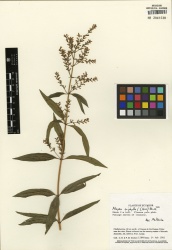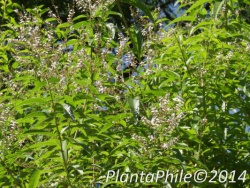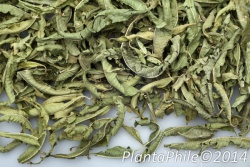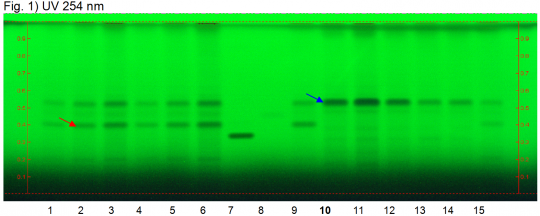Aloysia citrodora (leaf)
Contents |
Nomenclature
Aloysia citrodora Palau Verbenaceae
Syn. Aloysia triphylla (L'Hér.) Britton; Lippia citriodora Kunth, nom . illeg.
Standardized common name (English): lemon verbena
Botanical Voucher Specimen
|
|
Organoleptic Characteristics
Macroscopic Characteristics
|
|
|
Microscopic Characteristics
High Performance Thin Layer Chromatographic Identification
|
Lemon verbena (leaf) (Aloysia citrodora) Lane Assignments Lanes, from left to right (Track, Volume, Sample):
Reference Sample(s) Reference: Dissolve 1 mg of rutin in 5 mL of methanol. Dissolve 1 mg of arbutin in 5 mL of methanol. Stationary Phase Stationary phase, i.e. Silica gel 60, F254 Mobile Phase Formic acid, acetic acid, water, ethyl acetate 11:11:27:100 (v/v/v/v) Sample Preparation Method Sample: Mix 500 mg of powdered sample with 5 mL of methanol and sonicate for 10 minutes, then centrifuge or filter the solutions and use the supernatants / filtrates as test solutions. Derivatization reagent: Anisaldehyde reagent, Preparation: 170 mL of ice-cooled methanol are mixed with 20 mL of acetic acid, 10 mL of sulfuric acid and 1 mL of anisaldehyde, Use: Dip (time 0, speed 5), heat at 100°C for 5 min. Detection Method Saturated chamber; developing distance 70 mm from lower edge; relative humidity 33% Other Notes Images presented in this entry are examples and are not intended to be used as basis for setting specifications for quality control purposes. System suitability test: Rutin: light yellow zone at Rf ~ 0.34 (white RT); Arbutin: light brown zone at Rf ~ 0.46 (white RT). Identification: Compare result with reference images. The fingerprint of the test solution is similar to that of the corresponding botanical reference sample. Additional weak zones may be present. Under UV 254 nm the chromatogram of the test solution shows one quenching zone at Rf ~ 0.53. Under white RT there is a brownish grey zone at Rf ~ 0.53 above the position of reference arbutin (blue arrow). A greyish violet double zone is seen around Rf ~ 0.30 just below reference rutin. Test for adulteration: No zone is seen at Rf ~ 0.40 (red arrow, European vervain herb). Source: HPTLC Association [4] |
Supplementary Information
Sources
- ↑ MOBOT, Tropicos.org http://www.tropicos.org/Image/100000673
- ↑ PlantaPhile http://plantaphile.com/
- ↑ PlantaPhile http://plantaphile.com/
- ↑ HPTLC Association http://www.hptlc-association.org/



